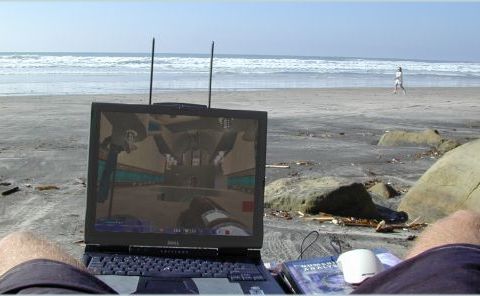Het zonnetje schijnt buiten, maar de die-hard tweaker kan natuurlijk niet zomaar z'n huis verlaten zonder internetverbinding. Tot kort geleden was het alleen mogelijk om tegen hoge kosten een crappy 9k6 verbinding te leggen via een mobiele telefoon, maar met de komst van speciaal op data gerichte standaarden als GPRS en UMTS begint dat te veranderen. Ars Technica bekijkt de 3G netwerktechnologie in de praktijk, en maakt daarbij gebruik van een Qualcomm 1xEV-DO. Dit single carrier apparaat kan downloaden tot 2,4 megabit en uploaden met 153 kilobit. Wie dat al veel vindt zal helemaal staan te kijken van de mogelijkheden die multiple carrier standaarden in de toekomst zullen hebben. Of deze beloofde snelheid ook echt gehaald wordt lees je hieronder:
Being handed a modem and told it does 2.4 Mbps is a lot like getting a new car that says 155 MPH on the speedometer: Oh, yeah? Since I knew where the cell sites were, I took my laptop and plopped myself down 200 yards from the transmitter with a clear line of sight to test best-case conditions. Download speeds were up to 285 KB/sec — that's 2.2 Megabits of actual application-level data throughput. Not even many wired LAN connections hit 90% of peak, let alone wireless connections. Downloads of greater than 200 KB/sec were not uncommon from well-connected web and FTP sites. (From here on, KB=kilobytes.) 1xEV has a maximum upload speed of 19.2 KB/sec and uploading at 18 or 19 KB/sec was easy to achieve.
Subjectively speaking, day-to-day browsing is fast, comparable to cable or DSL. In well-covered areas you would be hard-pressed to tell that you're not browsing through a landline. Transfer rates averaging in the 50-150 KB/sec range are fairly typical. However, being a wireless technology, 1xEV is subject to the same connection vagaries as cellular phones and other wireless data connections like 802.11b. Data rate is a function of distance to the nearest base station(s), the intervening geography, and the number of users on the air. You may be out in the open getting good download speeds and then go behind a building or down into a valley and see your connection quality plummet or even disappear completely.
 |
Voor verdere informatie, zoals over de levensduur van de accu, de veiligheid en de stoere monitoring features kun je terecht bij de review van Ars Technica. De vraag is echter wanneer dit alles echt gaat aanslaan, en hoe duur het allemaal gaat worden. Met dank aan Verwijderd voor de tip.
